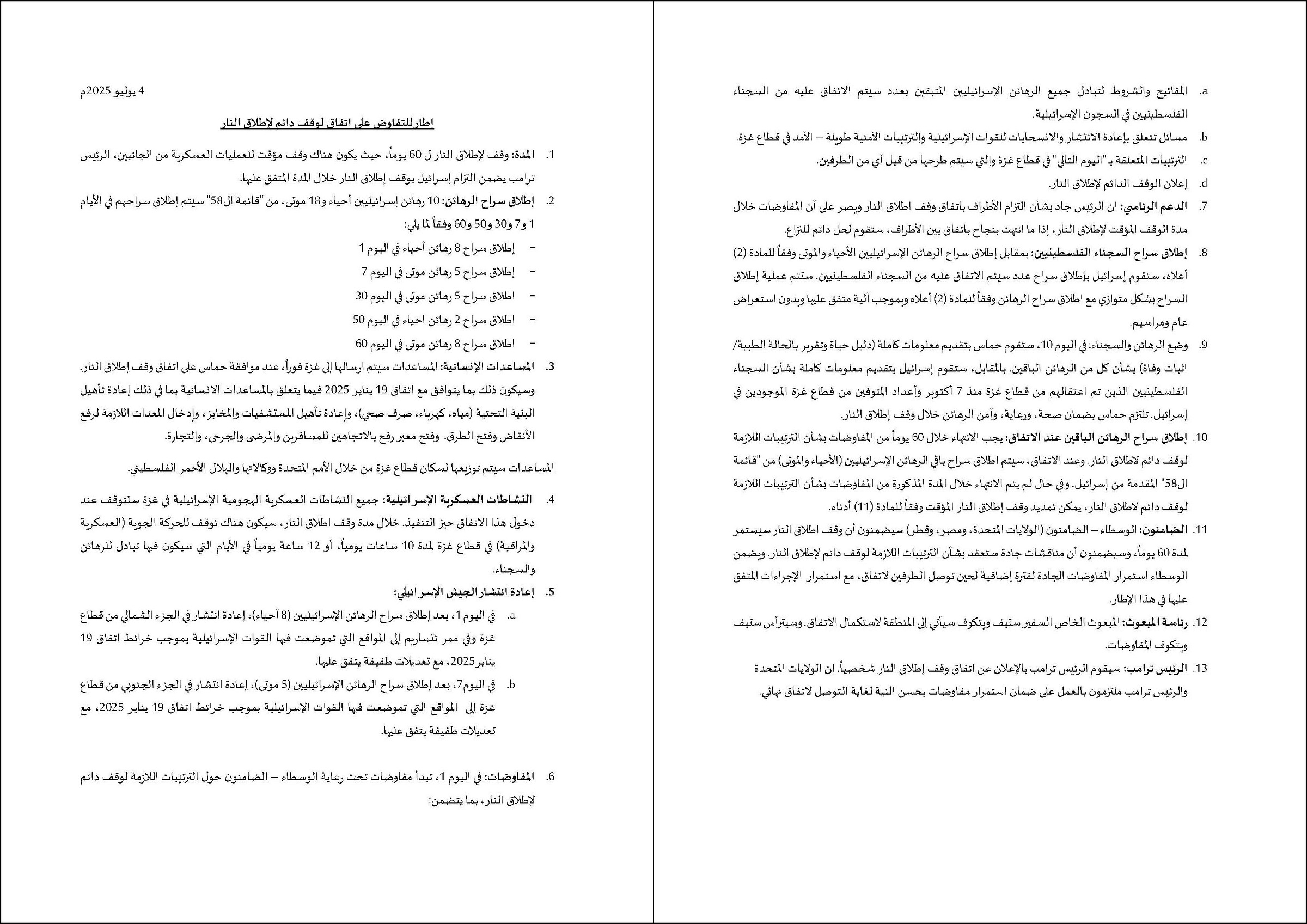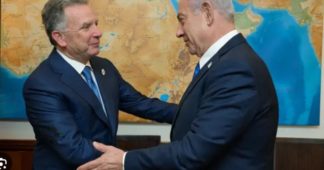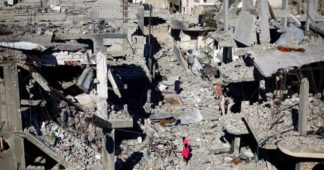Jeremy Scahill and Jawa Ahmad
Jul 10, 2025
Hamas accused the U.S. and Israel of waging a campaign of disinformation about ceasefire progress and insists it will not retreat from its “red lines.
President Donald Trump has portrayed a new Gaza ceasefire deal as a near certainty, claiming it could be signed as early as this week. “We gotta get that solved. Gaza is—it’s a tragedy and [Israeli Prime Minister Benjamin Netanyahu] wants to get it solved, and I want to get it solved, and I think the other side wants to get it solved,” Trump said Tuesday. “A lot of hate, long-term hate, but we think we’re going to have it solved pretty soon—hopefully with a real solution, a solution that’s going to be holding up.”
The indirect proximity talks underway in Doha may lead to an agreement on a ceasefire framework, particularly if Trump decides he wants a deal and is willing to force Netanyahu to make concessions. But a Hamas official with direct knowledge of the negotiations in Qatar told Drop Site Wednesday morning that, since Sunday, the U.S. and Israel have engaged in a “deception game,” one aimed at strong-arming Hamas into signing an agreement that would not end the genocide; permit Israeli forces to remain deeply entrenched in the enclave; and keep Israel in effective control of whether—and under what conditions— food, medicine, and other life essentials are allowed to enter Gaza.
The Hamas official said the Islamic resistance movement will not compromise on a core set of “red lines” it has established for any ceasefire: that there will be a full withdrawal of Israeli occupation forces and that the UN, not Israel, will control humanitarian aid going into Gaza—administered on the terms of the original January 19 ceasefire deal that Israel unilaterally abandoned. Hamas also wants stronger language stating that Trump would guarantee that Israel maintains a ceasefire after an initial 60-day truce and exchange of captives to negotiate an end to the war.
“The only party capable of imposing a ceasefire on the occupation is the United States of America,” said Taher Al Nunu, a senior Hamas official, in a statement to Al Jazeera on Wednesday. He added that, while Hamas appreciates the work of the regional mediators from Egypt and Qatar to bridge gaps, the U.S. “itself is the one that can force Israel to stop this war and this aggression. Therefore, if the political will and real guarantees from the United States are available, we are convinced that we will reach an end to this war.”
Hamas’s overarching aim is to return to the basic terms—on aid distribution, Israeli troop positions, and negotiations on a permanent ceasefire—enshrined in the January agreement signed by Israel and endorsed by Trump and former President Joe Biden.
On Tuesday, Trump Special Envoy Steve Witkoff claimed that the talks in Doha were yielding progress. “We’re in proximity talks now, and we had four issues, and now we’re down to one after two days of proximity talks,” Witkoff claimed. “So, we are hopeful that by the end of this week, we will have an agreement that will bring us into a 60-day ceasefire.”
The Hamas official told Drop Site that Witkoff was lying in his claim that there was only one outstanding issue to be resolved. “We insist on our demands,” the official said, adding that the proposed terms laid out in Hamas’s July 4 document remained unchanged, despite media reports to the contrary.
His comments were echoed in a public statement released by senior Hamas official Izzat al-Rishq on Tuesday night. “Gaza will not surrender—and it is the resistance that will impose the terms, just as it has imposed the equations,” he said.
The Hamas official noted that a Qatari delegation visited the White House Tuesday for talks with senior U.S. officials about a potential Gaza deal. He suggested that Witkoff’s comments about successfully resolving some issues may reflect terms the U.S. and Israel have told mediators they’ve agreed to—not compromises reached between Israel and Hamas. He dismissed media reports, purporting to reveal Hamas’s concessions on its “red line” issues during the proximity talks, as “totally false.” Much of the negotiating, he said, appeared to be between Israel and the U.S.
In a statement on Wednesday, Hamas denounced what it called Israel’s “obstinacy” in the ceasefire negotiations.

Status of the Negotiations
During the indirect proximity talks that began in Doha on Sunday, Israeli negotiators offered no significant concessions, despite pervasive reports in the Israeli press that the U.S. was applying pressure on Netanyahu, according to the Hamas official. Instead, he said, Israel amplified its threats to expand its military presence in southern Gaza, according to the Hamas official. “All of this is to prepare for their plans of forceful—or ‘voluntary’—emigration of the Palestinians,” he said.
Israel’s defense minister confirmed as much on Monday, saying that Israeli forces intend to build what he cynically called a “humanitarian city” on the rubble of what was once the city of Rafah, near the Egyptian border. As part of any deal, Israel said it wanted to keep its forces positioned in a 7.5 mile-wide stretch of southern Gaza between the Philadelphi corridor and the so-called Morag Axis, which Israel created in April, separating Rafah from Khan Younis. It is near this area that hundreds of Palestinians have been killed since late May as they sought meager food rations from the U.S.-Israeli-created Gaza Humanitarian Foundation (GHF).
Israel Katz, the defense minister, claimed that an initial 600,000 Palestinians would be confined to the camp and would not be allowed to leave. They would be subjected to “security screenings,” ostensibly to ensure they have no connection to Hamas, and then housed in tents.
“The plan is essentially to move all civilian Gazans south to a large tent city in Rafah, where they will have hospitals and plenty of food,” an Israeli source told Haaretz. “How did the prime minister put it? Give them Ben & Jerry’s, for all I care.” The paper said Netanyahu hopes to convince Saudi Arabia or the United Arab Emirates to eventually take over the administration of the camp. It cited an Israeli official as saying that Netanyahu believes that “if we do it, it will incentivize the Emiratis or the Saudis to take over it and say, ‘We’re freeing you from Israeli control.’ They will have legitimacy to intervene, without being considered collaborators with Israel, since they won’t want to take part in a plan that empties the northern part of the Gaza Strip.”
The ultimate aim of the camp, Katz said, was to force the population to “voluntarily emigrate” to other countries—a goal that, he pledged, “will happen.” Katz said that construction in the zone could begin during a potential 60-day truce.
“We’re working with the United States very closely about finding countries that will seek to realize what they always say, that they wanted to give the Palestinians a better future,” Netanyahu claimed after meeting with Trump on Tuesday evening, his second face-to-face with Trump since he landed in Washington D.C. on Monday. “I think we’re getting close to finding several countries.”
But, on Wednesday, Axios reported that the Trump administration now understands that Hamas will not agree to a deal that includes large deployments of Israeli troops remaining inside Gaza. During the White House meetings on Tuesday between Qatari officials, Witkoff, and Ron Dermer, Netanyahu’s point man on the Gaza negotiations, the Qatari official and Witkoff “made it clear to Dermer that the map proposed by Israel—which involves a far more narrow redeployment than the one the IDF carried out during the previous ceasefire—is a non-starter,” according to Axios. A Qatari official said the issue could collapse the talks. Witkoff, according to Axios, told Dermer that Trump opposed “an ongoing Israeli occupation of large parts of the Gaza Strip.” Israel then suggested revised maps to the mediators, the report said.
“This is media talk. We need to see the maps on the ground,” said Dr. Mohammed Al-Hindi, the lead negotiator for Palestinian Islamic Jihad, in an interview with Al Araby on Wednesday evening. He called Israel’s planned camp in Rafah, in southern Gaza, the “Morag ghetto.”
The Hamas official told Drop Site that, late Wednesday, Israel submitted a new proposal to mediators demanding the creation of an Israeli-controlled buffer zone encircling Gaza that would extend two kilometers into Gaza in the north and east of the enclave, as well as a four kilometer (2.5 mile) zone cutting through southern Gaza. This would mean that the Rafah crossing along the Egyptian border—Gaza’s only gateway to the outside world before Israel seized it— would be under full Israeli control. The Hamas official described it as creating a “Rafah ghetto.” He said Hamas would not agree to the terms.
Israel’s Channel 14 reported details consistent with what the Hamas official said, saying that Netanyahu had ordered the Israeli military to draw a line “that can be lived with.” The goal would be “to create another southern closure besides Philadelphi, and thus perhaps withdraw from the Morag Axis and move toward a [ceasefire] deal.”
In the modified ceasefire draft Hamas submitted July 4, the terms called for Israeli troops to be withdrawn to their positions from March 2, the day Israel abandoned the original ceasefire deal. This would mean the forces near Rafah would need to begin withdrawing in the second week of a new ceasefire deal, rather than establishing a militarized prison-style camp in southern Gaza. Hamas also proposed that the Rafah border crossing with Egypt be re-opened “in both directions for travelers, the sick, the wounded, and trade.”
Hamas has insisted that it wants the UN and the Red Crescent to administer the distribution of aid to Gaza under the terms of the January ceasefire deal. The Trump-backed draft of the latest ceasefire framework, said that while the UN would participate in distribution, it would not be in charge. Israel has demanded that Israeli forces retain this authority. The Hamas official said that Israel’s system is one of “death traps” for starving Palestinians.
In an interview broadcast on FOX News on Wednesday, Netanyahu said the UN would likely be “among” the entities involved with aid distribution. “But we have our own distribution system that has been established to prevent Hamas from stealing the food that is supposed to go to the population,” Netanyahu said. “Obviously we don’t want to give up the thing that we began with, which is distribution that goes directly to the people…. I think we’ll end up for the 60 days with both.” There is no evidence that Hamas has seized any significant quantities of aid, a point that a European Commission spokesperson reiterated this week.
Al-Hindi said the Palestinian negotiators oppose any involvement of the GHF aid scheme in a potential ceasefire deal, saying it would be used— alongside the Morag camp—as part of the plan to ethnically cleanse Palestinians out of Gaza.
“This institution that is cloaked in humanitarianism is a new crime of killing people. We have seen over the past months that hundreds of Palestinians have been targeted, including women, children, and defenseless civilians who have no ties—except wanting to feed their children,” he said. “Now they want to establish it in an agreement? That is, we give it legitimacy by establishing it in this agreement. The areas under Israeli control [where GHF operates] are merely buffer zones with no residents. The United Nations intervenes to provide relief to the Palestinian people in areas with residents.”
Israel’s Foreign Minister Gideon Saar said on Wednesday, “If a temporary ceasefire is reached, we are willing to negotiate a permanent one.” This could be interpreted as a new development, one which Hamas has demanded that Trump guarantee, but Saar also reiterated the maximalist position Israel has taken from the beginning, claiming the war “can end tomorrow if Hamas releases [all Israeli captives] and lays down its weapons.” He added: “Hamas is not only responsible for initiating this war, but also for its continuation. Pressure must be applied to Hamas.”
Throughout various ceasefire negotiations during the past 22 months of Israel’s war, the U.S. and Israel have worked in tandem to submit ultimatums to Hamas, and when Palestinian negotiators seek amendments, the U.S. and Israel claim that Hamas has rejected peace as the Israeli military assault on Gaza intensifies, facilitated by U.S. arms and political support. When it has signed such agreements, Israel repeatedly violates the terms and continues killing Palestinians. Israeli officials have claimed that Trump offered Netanyahu another “side letter” authorizing a resumption of the war as part of any deal signed with Hamas.
During the FOX News interview Wednesday, Netanyahu was asked if Israel would resume the war should Hamas violate a ceasefire. “That’s obvious. We have the right of self-defense at any time,” he replied. Netanyahu made no mention of the fact that Israel repeatedly violated the January Gaza ceasefire deal and then abandoned it before resuming its military assault. “I think on these matters, which I always prefer to negotiate not in front of a camera, I think there’s a good chance we’ll have this ceasefire and that will get us closer to the goal I set from the beginning: Let’s get [the Israeli captives] all back without capitulation.”
Netanyahu referred to Hamas as “monsters,” and said, “They’re actually as bad—and in some cases—worse than the Nazis.” He promised that, after a ceasefire, “They’re not going to be there. So we get our hostages out. We’re going to take out Hamas, and we’re going to make sure that Gaza no longer poses the threat to Israel or to anyone else.”
On July 4, Hamas submitted a handful of proposed modifications to the framework Trump called the “final proposal.” In doing so, Hamas made a series of concessions, including a willingness to release eight living Israeli captives on the first day of a temporary truce. On day 50 of a deal, Hamas would release another two, bringing the number of living captives it holds down to ten. Hamas has said it is aware that these captives are the strongest bargaining assets that it holds.
Asked whether he believed a deal could be reached this week, Al-Hindi said, “I can’t say it’s out of the question. We’re interested in reaching an agreement and are making a great effort, and the mediators are interested in reaching an agreement. If Israel and Netanyahu want to reach an agreement, [we can reach one] in five minutes.” He charged that Netanyahu “wants a partial deal to manage the continuation of the war and the continuation of the aggression” and to maintain a veto over continuing the talks beyond 60 days. “Trump guarantees the continuation of the ceasefire if the negotiations continue. But if they don’t continue? If Israel stops them? There is no guarantee.”
Even if an agreement was reached on a framework for a ceasefire, there remain myriad technical issues to resolve, any one of which could stall or destroy a potential deal.
“What is being talked about is a general framework paper and detailed talks have not yet begun… We seek to bridge the gap for the negotiating framework and to find a suitable environment,” said Qatar’s Foreign Ministry spokesperson Dr. Majed Al Ansari Tuesday. “We are not yet talking about a final agreement.”
Multiple news outlets have reported that Trump’s unofficial envoy, Palestinian-American academic Bishara Bahbah, passed another message to Hamas assuring the movement that Trump was committed to sustaining the ceasefire beyond an initial two-month truce in order to achieve a permanent resolution. In the past, Hamas has said such informal pledges were insufficient.
“No one can guarantee Israel’s actions. These are merely symbolic guarantees,” said Al-Hindi, the Islamic Jihad negotiator who is part of the Hamas-led Palestinian delegation. “President Trump wants to come out and talk about the agreement. He and [the other U.S. officials] don’t care about all the details we’re talking about, while we’re suffering on the ground and the killing we’re seeing. No one cares about this. They care about the image.”
The Times of Israel reported Wednesday that, while the Trump administration does not want Israel to resume the war after a 60-day truce, “the U.S. does not want that possibility ruled out in the text of the ceasefire proposal in order to hold Hamas’s feet to the fire and make sure that they negotiate in good faith.”
On Tuesday, Netanyahu declared, “We are determined to achieve all our objectives: the release of all our hostages—both the living and the fallen, the elimination of Hamas’s military and governing capabilities, and thereby ensuring that Gaza will no longer pose a threat to Israel.”
Al-Rishq, the senior Hamas official, said Netanyahu’s statement “reflects the illusion of psychological defeat,” adding: “After the enemy’s leaders acknowledged their abject failure to recover their captives through military operations, it became clear that the only way to release them was through a serious deal with the resistance.”
Al-Hindi acknowledged the pressure coming from Palestinians inside Gaza to reach a deal. “Our people know the suffering, and right now all they want is to hear that an agreement has been reached,” he said. “God willing, we will come out with an agreement that will remove this oppression, this killing, and this great pain from them.”
He added: “We want to protect them after the 60 days as well. The issue is not just to stop the killing for a specific period. We want to protect our people, and protecting our people is not dependent on an agreement that Trump or someone else will sign. It is dependent on this legendary steadfastness that the Palestinian people have achieved.”
Below is the full text of Hamas’s amended proposal for a Gaza ceasefire, which Drop Site translated into English:
4 July 2025
Framework for Negotiating an Agreement to a Permanent Ceasefire
1. Duration: A 60-day ceasefire, during which there will be a temporary cessation of military operations by both sides. President Trump guarantees Israel’s adherence to the ceasefire during the agreed-upon period.
2. Release of Hostages: 10 Israeli live hostages and 18 deceased hostages from the “List of 58” to be released on days 1, 7, 30, 50, and 60, as follows:
- 8 live hostages released on day 1
- 5 deceased hostages released on day 7
- 5 deceased hostages released on day 30
- 2 live hostages released on day 50
- 8 deceased hostages released on day 60
3. Humanitarian Assistance: Aid will be sent into Gaza immediately once Hamas agrees to the ceasefire agreement. This will be in accordance with the January 19, 2025, agreement regarding humanitarian aid, including the rehabilitation of infrastructure (water, electricity, and sanitation), the rehabilitation of hospitals and bakeries, the entry of equipment necessary for removing rubble and opening roads, and the opening of the Rafah crossing in both directions for travelers, the sick, the wounded, and trade.
Aid will be distributed to the population of the Gaza Strip through the United Nations, its agencies, and the Palestinian Red Crescent.
4. Israeli Military Activities: All offensive Israeli military activities in Gaza will cease upon this agreement entering into force. During the ceasefire period, there will be a cessation of aerial movement (military and surveillance) in the Gaza Strip for 10 hours daily, or 12 hours daily during days involving hostage and prisoner exchanges.
5. Israeli Military Redeployment:
- On Day 1, after the release of the Israeli hostages (8 living), redeployment will take place in the northern part of the Gaza Strip and in Netzarim corridor to the positions where Israeli forces were deployed according to the maps of the January 19, 2025 agreement, with minor adjustments to be agreed upon.
- On Day 7, after the release of the Israeli hostages (5 deceased), redeployment in the southern part of the Gaza Strip to the positions where Israeli forces were deployed according to the maps of the January 19, 2024 agreement, with minor adjustments to be agreed upon.
6. Negotiations: On Day 1, negotiations will begin under the auspices of the mediators-guarantors on the necessary arrangements for a permanent ceasefire, including:
- Keys and terms for the exchange of all remaining Israeli hostages for an agreed-upon number of Palestinian prisoners in Israeli prisons.
- Issues relating to redeployments and withdrawals of Israeli forces and long-term security arrangements within the Gaza Strip.
- Arrangements relating to the “day after” in the Gaza Strip, which would be raised by either side.
- The announcement of a permanent ceasefire.
7. Presidential Support: The President is serious about the parties’ adherence to the ceasefire agreement and insists that negotiations during the temporary ceasefire, if successfully concluded by an agreement between the parties, would lead to a permanent resolution of the conflict.
8. Release of Palestinian Prisoners: In exchange for the release of the living and dead Israeli hostages in accordance with Article 2 above, Israel will release an agreed-upon number of Palestinian prisoners. The release will take place in parallel with the release of the hostages in accordance with Article 2 above, according to an agreed-upon mechanism, and without public displays or ceremonies.
9. Status of Hostages and Prisoners: On Day 10, Hamas will provide complete information (proof of life and medical status report/proof of death) regarding each of the remaining hostages. In return, Israel will provide complete information regarding the Palestinian prisoners detained from the Gaza Strip since October 7 and the number of deceased Gazans held in Israel. Hamas commits to ensuring the health, welfare, and security of the hostages during the ceasefire.
10. Remaining Hostages Released Upon Agreement: Negotiations on the necessary arrangements for a permanent ceasefire must be concluded within 60 days. Upon agreement, the remaining Israeli hostages (living and deceased) from the “List of 58” submitted by Israel will be released. If negotiations on the necessary arrangements for a permanent ceasefire are not completed within the aforementioned period, the temporary ceasefire may be extended in accordance with Article 11 below.
11. Guarantors: The Mediators—Guarantors (the United States, Egypt, and Qatar) will ensure that the ceasefire will continue for 60 days and that serious discussions will be held on the necessary arrangements for a permanent ceasefire. The Mediators will ensure that serious negotiations continue for an additional period until the parties reach an agreement, with the continuation of the agreed-upon measures in this framework.
12. Envoy Presides: Special Envoy Ambassador Steve Witkoff will travel to the region to finalize the agreement. Steve Witkoff will preside over the negotiations.
13. President Trump: President Trump will personally announce the ceasefire agreement. The United States and President Trump are committed to working to ensure that good faith negotiations continue until a final agreement is reached.
We remind our readers that publication of articles on our site does not mean that we agree with what is written. Our policy is to publish anything which we consider of interest, so as to assist our readers in forming their opinions. Sometimes we even publish articles with which we totally disagree, since we believe it is important for our readers to be informed on as wide a spectrum of views as possible.











